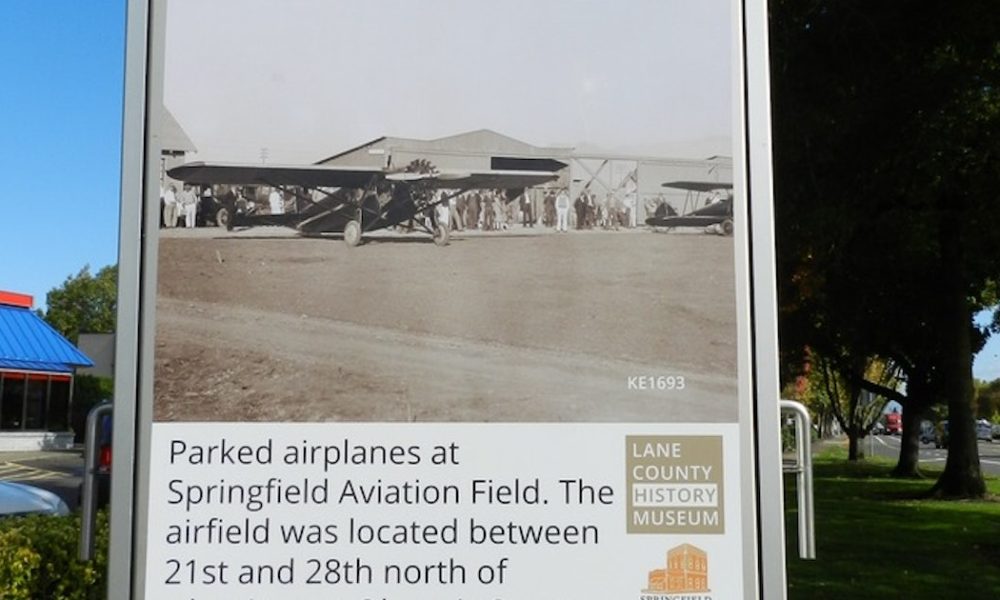 An airfield previously located near Olympic Street between 21st and 28th streets is pictured on the History Here poster installed in that area. Victoria Stephens/The Chronicle
An airfield previously located near Olympic Street between 21st and 28th streets is pictured on the History Here poster installed in that area. Victoria Stephens/The Chronicle
SPRINGFIELD – If you haven’t seen the History Here poster on the northeast corner of 18th and Olympic streets, you might not know that up until the 1960s an airfield ran just north of there from 21st to 28th streets.
The poster is part of a series of historic posters, which can be found throughout Springfield and other areas of Lane County. They are a part of the History Here program, organized by the Lane County History Museum, the Shelton McMurphey Johnson House, the Springfield Museum and the Schwemm Family Foundation.
The four installations in Springfield were coordinated and installed in conjunction with the Springfield Historic Commission, said Jenna Fribley, a Springfield architect and co-founder of Campfire Collaborative: Architecture & Design firm.
The posters are large and made of vinyl, adhered to electrical transformer boxes at various street intersections.
The posters are installed on utility boxes proximate to pedestrian areas, requiring coordination with the city and the utility provider, she said. The posters bear photos from historical periods and events that occurred at or near each site.
In addition to the historical airport photo, with crop dusters and hobby planes lined up along Olympic Street in front of Burger King, a poster showing the original Paramount Market is located in front of what has become the Antique Mall at 21st and Main streets. The photo from 1945 shows vintage vehicles parked in front of what at the time was a new supermarket, which included a soda fountain and lunch counter as well as a pharmacy.
At the corner of 3rd and A streets. the EMX bus line of Lane Transit District runs along the same path as the electric streetcars did in 1910. The History Here poster at that location shows the grand opening of the new electric-powered line with a flag-decorated streetcar on tracks embedded into a dirt road, surrounded by crowds in period dress.
The streetcar is stopped in front of the Springfield Hotel, with its grand balcony, which used to be at that location.
Beside historical photographs, each poster tells a bit of history of that location.
In the case of the streetcar photo, information about the newly constructed streetcar bridge over the Willamette River is given. The poster provides additional background on its use by drinkers during the Prohibition era, as Eugene residents would take the streetcar from the dry city of Eugene to the wet city Springfield to get liquored up, ”on a jag.”
Fribley said that behind the hotel there used to be a small jail that served as a drunk tank for revelers that got too drunk to make the voyage back over the river.
The fourth installation in Springfield, at the northeast corner of 2nd and A streets, shows that Springfield once had its own ”Hollywood-style” sign on top of the butte overlooking the entrance into the city. The large white letters, once electrically lit, sat on the hilltop at Willamette Heights. This type of signage over a city was popular in the 1900s, as a type of real estate advertisement.
”The program started in Eugene in 2014, and we’ve been slowly expanding it to other areas,” said
Leah Murray, executive director of the Shelton McMurphey Johnson House. ”In 2017, I got a grant from the Schwemm Family Foundation,” she said.
The grant was to produce and install the posters in outlying communities of Lane County, outside of Eugene. The Lane County History Museum received an award from the State Heritage Association a couple of years ago for this project, she said.
Beside the original 13 sites throughout Eugene, there are two installations in Veneta, two in Florence, two planned for Creswell and the four in Springfield. Additionally, there are five installations in Cottage Grove, a couple in McKenzie Bridge, and Oakridge also has a version, she said. These were done by the Lane County History Museum in connection with the local museums.
”As we have expanded the project we have gone to the various museums in the various communities and worked with them,” Murray said. ”History doesn’t just have to live in some museum. History happens in places outside of the museum.”








